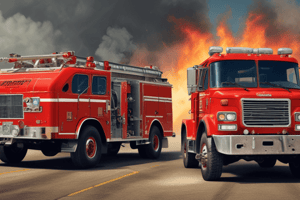Podcast
Questions and Answers
What is the primary purpose of the natural gas protocol mentioned in the text?
What is the primary purpose of the natural gas protocol mentioned in the text?
- To ensure the safety of personnel and provide a standardized response (correct)
- To regulate the use of natural gas in structures
- To mitigate all hazardous materials incidents
- To address potential hazards in natural gas emergencies
What is a caution mentioned in the text regarding potential hazards of natural gas?
What is a caution mentioned in the text regarding potential hazards of natural gas?
- Vapors are not likely to cause explosions
- Under fire conditions, containers may explode (correct)
- Gas is heavier than air and may enter nearby structures
- Vapors are harmless if ignited in an enclosed area
What is the caution about vapors mentioned in the text?
What is the caution about vapors mentioned in the text?
- Vapors may explode if ignited in an enclosed area (correct)
- Vapors always sink to the lowest point and do not collect
- Vapors are harmless and do not pose any risk
- Vapors do not pose any risk in enclosed spaces
What is the specific focus of the guidelines mentioned in the text?
What is the specific focus of the guidelines mentioned in the text?
What is the emergency hotline number for the given compressed natural gas containers?
What is the emergency hotline number for the given compressed natural gas containers?
What should be done in the event of relief valve discharge with fire?
What should be done in the event of relief valve discharge with fire?
What is the flash point of the gas mentioned in the text?
What is the flash point of the gas mentioned in the text?
What is the physical state of the gas at 15°C and 1 atm?
What is the physical state of the gas at 15°C and 1 atm?
What is the specific gravity of the vapor (gas) at 20°C?
What is the specific gravity of the vapor (gas) at 20°C?
What are the chemical designations for the gas mentioned in the text?
What are the chemical designations for the gas mentioned in the text?
What is the behavior of the vapor in fire?
What is the behavior of the vapor in fire?
What are the NFPA hazard classifications for the gas mentioned in the text?
What are the NFPA hazard classifications for the gas mentioned in the text?
What are the main objectives for dealing with flammable gases?
What are the main objectives for dealing with flammable gases?
What are the key actions upon arriving at the scene of a flammable gas incident?
What are the key actions upon arriving at the scene of a flammable gas incident?
Which specific protocols exist for dealing with vapor discharge in open air, confined areas, and vapor fires in pipelines?
Which specific protocols exist for dealing with vapor discharge in open air, confined areas, and vapor fires in pipelines?
What are the tactical objectives for dealing with the smell of gas in a structure?
What are the tactical objectives for dealing with the smell of gas in a structure?
What precautions should be considered for dealing with natural gas incidents?
What precautions should be considered for dealing with natural gas incidents?
What procedures are involved in dealing with compressed natural gas incidents?
What procedures are involved in dealing with compressed natural gas incidents?
What must the first responder on the scene follow?
What must the first responder on the scene follow?
When is it necessary to notify Teco?
When is it necessary to notify Teco?
Flashcards are hidden until you start studying
Study Notes
Natural Gas Emergency Response Protocols
- The main objectives for dealing with flammable gases are evacuating civilians, isolating the leak source, and controlling the leak.
- Key actions upon arriving at the scene include size-up, establishing command, determining incident level, requesting resources, establishing accountability, securing the area, controlling ignition sources, and establishing hot, warm, and cold zones.
- Specific protocols exist for vapor discharge in open air, confined areas, and vapor fires in pipelines, including steps for evacuation, re-routing traffic, and contacting technical assistance.
- Tactical objectives for dealing with the smell of gas in a structure include confirming gas presence, shutting off the gas, isolating ignition sources, and ventilating the interior.
- Precautions include the potential for flashback, explosion, and vapor collection in high areas.
- Procedures for dealing with compressed natural gas incidents involve evacuating civilians, securing ignition sources, and cooling exposed containers in case of a fire.
- Primary tactical objectives for such incidents are isolating ignition sources and turning off the tank valve.
- The first responder on the scene must follow the department's IMS Protocol, determine the incident level, request resources, establish accountability, secure the area, control ignition sources, and establish hot, warm, and cold zones.
- It is necessary to notify Teco for all leaks or ruptures of natural gas distribution lines.
Studying That Suits You
Use AI to generate personalized quizzes and flashcards to suit your learning preferences.



